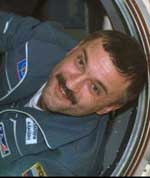
Image credit: NASA
As of Sunday, November 2, the International Space Station has had humans on board for three years. The current crew, Expedition 8, arrived on board only a few weeks ago to replace Expedition 7 who had been on board for six months. With the loss of the space shuttle Columbia earlier this year, construction on the station has come to a halt. 76,000 kg of new equipment is currently being readied for launch, including scientific laboratories and new solar panels.
In a period that has exemplified the benefits of international cooperation in space, the International Space Station will complete a third year of permanent human presence aboard on Sunday, Nov. 2.
The third year of humans living aboard the station has been marked by the perseverance of the orbiting laboratory and international partnership through the tragedy of the Columbia accident.
“Every endeavour that continuously pushes the boundaries of human achievment can have times of both great triumph and great tragedy. The space agencies and nations around the world that are our partners in the Station understand that and they have experienced it,” ISS Program Manager Bill Gerstenmaier said. “The perseverance of crewed operations aboard the Station this year has brought the partnership closer together, and it will strengthen the Station through both the improvements in safety that we plan and the lessons we learn together.”
The eighth resident crew — Commander and NASA ISS Science Officer Mike Foale and Flight Engineer Alexander Kaleri — began a six-month stay aboard the complex Oct. 20.
The station remains the largest, most sophisticated and most powerful spacecraft ever built. Until the Space Shuttle fleet returns to flight, the transport of supplies and crews to the Station will be conducted by Russian spacecraft. The majority of power, cooling, volume and research capacity on the station are supplied by U.S. components. The station has a mass of almost 400,000 pounds and an interior volume roughly equal to that of a three-bedroom house. The U.S. Destiny Laboratory now houses seven different research facilities. The International Space Station partnership includes NASA; Rosaviakosmos, the Russian Space Agency; the Canadian Space Agency; the European Space Agency; and the Japanese Aerospace Exploration Agency.
At the Kennedy Space Center, Fla., 168,000 pounds of additional Station components are being prepared for launch when the Space Shuttle returns to flight. Those components will triple the number of science facilities aboard the orbiting laboratory, increase the total power available for research by over 80 percent and triple the surface area of the Station’s solar arrays. Among components at KSC is the second Station laboratory, the Japanese Experiment Module named Kibo.
Original Source: NASA News Release
